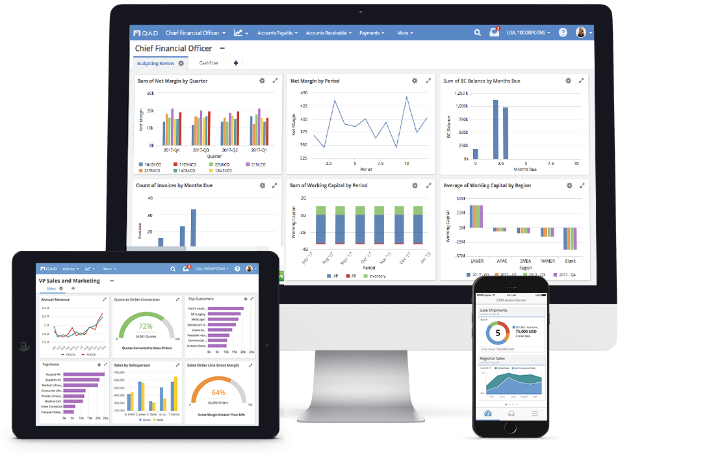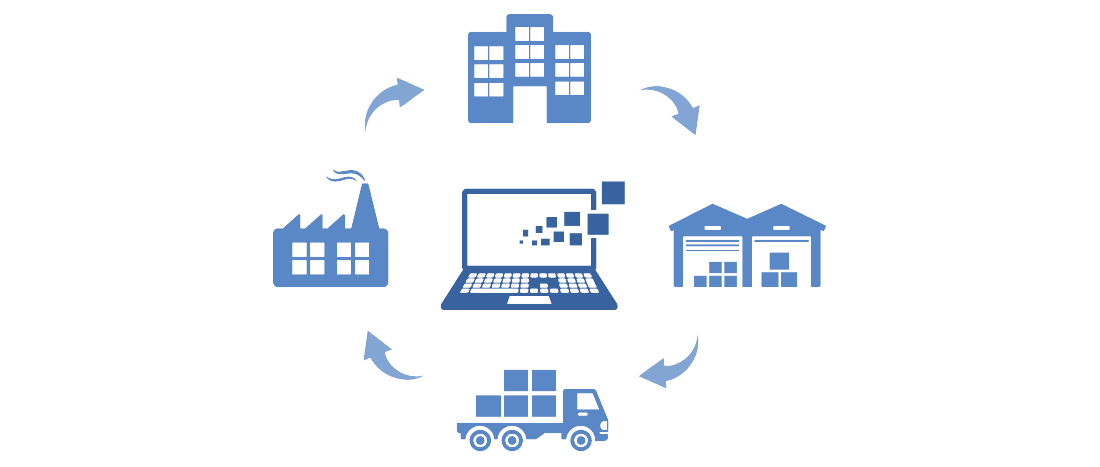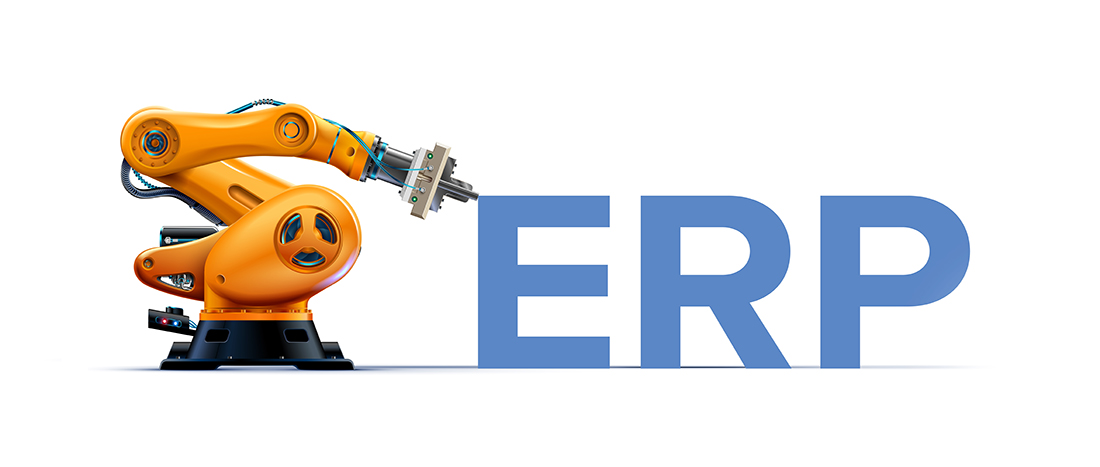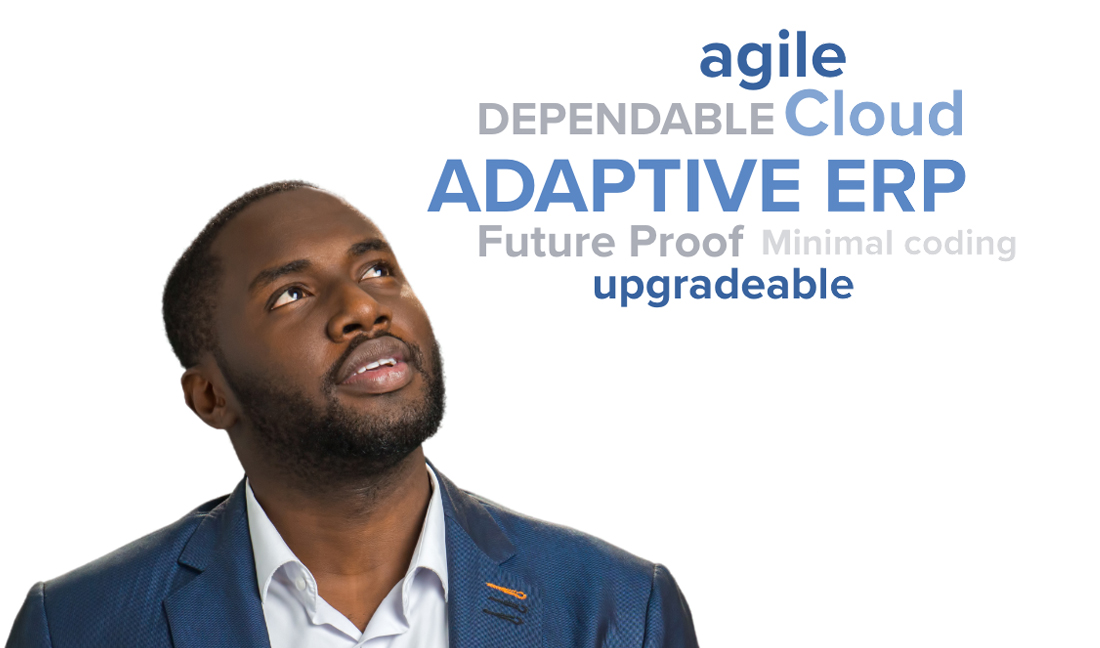ERPとは何ですか、なぜ企業で使用されるのですか?
ERPの定義
ERP は、エンタープライズ・リソース・プランニングの略であり、組織のすべてのコアサプライチェーン、製造、サービス、財務、その他のプロセスを計画し、管理するために使用されるソフトウェアとシステムを指します。エンタープライズ・リソース・プランニング ソフトウェアは、会計や調達、プロジェクト管理、顧客関係管理、リスク管理、コンプライアンス、サプライチェーンの運用など、ビジネスや組織全体の個々の活動を自動化し、簡素化するために使用することができます。
個々のERPアプリケーションは、Software as a Service (SaaS) を提供できますが、ERPアプリケーションの製品全体はERPシステムを形成し、ビジネスプロセスを効果的に通信および統合して、アプリケーション間のデータフローを可能にします。 使用形態は、オンプレミスまたはクラウドのいずれかです。
ERPは企業のあらゆる側面を結び付けます。 ERPソフトウェアシステムにより、パフォーマンスとプロジェクト管理が向上し、組織の財務状態とプロセスの計画、予算編成、予測、正確なレポートが可能になります。

What is an ERP System?
Individual ERP applications can offer software as a service (SaaS), while a complete suite of ERP applications forms an ERP system that can be used to effectively communicate and bring together a variety of business processes. ERP systems enable a flow of data between individual applications, typically through common databases either on-site/on-premise or in the cloud.
ERPs connect every aspect of an enterprise. An ERP software system allows for better performance and project management that helps plan, budget, predict and accurately report on an organization’s financial health and processes. ERP systems have become essential for businesses small, medium, and large across many industries.

ERPシステムはどのように機能しますか?
ERPの主な目的は、会社のリソースの活用方法を管理・改善することで、組織の効率を高めることです。品質やパフォーマンスを犠牲にすることなく、必要なリソースの数を改善・削減することが、事業の成長と収益性を効果的に向上させる鍵となります。

ERPシステムは通常、ビジネスオペレーションのすべての側面をカバーし、一般的に以下を提供します:
- 統合システム
- 共通データベース
- リアルタイム操作
- すべてのアプリケーション/コンポーネントをサポート
- アプリケーション/コンポーネント間で共通のユーザーインターフェース
- オンプレミス、クラウドホスティング、またはSaaSの導入
ERPソフトウェアは、部門間の指標を収集、比較し、役割や特定のユーザー設定に基づいて異なるレポートを提供する機能を持っています。収集したデータは、迅速にデータを見つけて報告することができ、リソースがどのように費やされているかについての完全なインサイトを持つビジネスパフォーマンスの完全なビューを提供します。
ERPは、レポートを生成するために手動でマージする必要がある個別のデータベースとスプレッドシートを維持する必要性を減らすことにより、レポートと自動化を同期します。 このデータ収集とレポートの組み合わせにより、コストの削減やプロセスの合理化などの貴重なインサイトが得られ、リアルタイムのビジネスディシジョンを行うための情報が提供されます。
ERPシステムの種類とERPソフトウェア導入オプション
ERPソフトウェアは、組織のソフトウェアニーズを満たし、ビジネスパフォーマンスを向上させるためのソフトウェアで、"エンタープライズ・アプリケーション" の一種と考えられています。企業規模、業務、および組織のニーズに応じて利用可能な多くの異なるERPシステムがあります。ERPシステムの種類は、一般的に展開オプションを参照して、クラウドERP、オンプレミスERPとハイブリッドERP (クラウド内の一部のシステムとオンプレミスの一部) が含まれています。
多くの場合、ERPシステムは、ビジネスのさまざまな側面をサポートし、組織のビジネス要件を満たし、さまざまな導入方法を持つように調整されています。
大企業向けERP vs. 中小企業向けERP
かつて "大企業向けERP" は、オンプレミスERPソリューションを展開することが多く、分析、カスタマイズ、アップグレード、展開を行うITおよびサポートに専念できる豊富なリソースを持っている大規模組織に適したソフトウェアソリューションでした。
"小規模企業向けERP"、"中小企業向けERP" というフレーズは、通常、中小企業の特定のニーズを満たすために作られたビジネス管理アプリケーションを備えたERPシステムを指します。
今日では、重要な要素は会社の規模や組織の規模に関係なく、ERPシステムが現在および将来のビジネス要件に効果的に対応しているかどうかを決定するため、現在これらのフレーズはあまり使用されていません。組織は、費用のかかるカスタマイズを排除し、急速なビジネス変化に適応し、将来のテクノロジーにも対処し、特定された他の要件を満たすERPシステムを検討および選択することが不可欠です。
ERPシステムの種類:クラウド vs. オンプレミス vs. ハイブリッド
ERPには主に3つのタイプがあり、異なる展開モデルオプションで機能します。 最も一般的なタイプのERPには、クラウドERP、オンプレミスERP、およびハイブリッドERPがあります。
- オンプレミスERPソフトウェアは、オンサイトで実装され、組織内の物理的なオフィススペースで維持され、完全な制御、サポート、および実装されると、システム全体の所有権のための会社独自のコンピュータやサーバー上でホストされています。
- クラウドベースのERPソフトウェアは、組織がアクセスし、通常、サブスクリプションの購入を介して、インターネット接続可能な任意のデバイス上でデータを保存するサービス (SaaS) として知られているWebベースのソリューションです。継続的なサポート、アップデート、トレーニング、およびソフトウェアプロバイダがサポートする柔軟なカスタマイズが特徴です。
- "ハイブリッド型" ERPソフトウェアは、クラウドベースとオンプレミスのERPシステムソリューションの組み合わせた実装を指します。ホスティングとデプロイメントサービスの組み合わせは、プロバイダによって異なります。これらのモデルは、ERPユーザーが配信モデル間で移行する柔軟性を提供したり、既存の実装では利用できない利点を統合することができます。
さまざまなERPベンダーがさまざまな導入モデルオプションをサポートしています。 オプションの組み合わせは、しばしば "ハイブリッド" 展開と呼ばれ、ホスティングサービスと展開サービスの組み合わせを提供する場合があります。 これらのモデルは、ERPユーザーに配信モデル間で柔軟な移行を提供したり、既存の実装では利用できないメリットを統合したりできます。
ERPはどの業界で使用できますか?
ERPソフトウェアは、ビジネスがより効率的にすることを支援するために、あらゆる業界で使用可能です。それは、社内外の部門間の情報を管理することができ、効果的なコミュニケーションツールを提供し、プロジェクトを管理するために日々の活動を支援し、ガイドラインへの遵守を追跡し、ビジネスを実行していることに伴う日々の複雑さを処理します。
製造業にはERPのルーツがあるため、さまざまな製造業界に対応する堅牢な業界固有のERPシステムがあります。 ERPは非常に多様であり、以下のような多くの業界の重要な位置づけとなります:
- 製造業
- 産業機械・部品
- 建築・住宅改修
- 電子工学と技術
- 自動車
- 航空宇宙・防衛
- ヘルスケア、医薬品、ライフサイエンス
- アグリビジネス、畜産、農業
- 食品・飲料
- ヘルスケアとホスピタリティ
- 衣料品・消費財・小売
時間の経過とともに、ERPシステムは他のアプリケーションのサポートと日々のビジネス機能をサポートする "ERPモジュール" を含むように成長しました。多くのERPシステムでは、以下のような一般的な機能領域がERPモジュールにグループ化されています:
- 財務会計
- 管理会計
- 人事
- 製造
- 注文処理
- サプライチェーンマネジメント
- プロジェクトマネジメント
- 顧客関係管理 (CRM)
- データサービス
ERPの簡単な歴史
"ERP"という用語は、1990年代にガートナー・グループによって最初に使用されましたが、エンタープライズ・リソース・プランニング ソフトウェアとシステムは100年以上にわたって製造業界で使用されており、業界のニーズの変化と成長に応じて進化し続けています。
ERPの歴史/タイムライン:
- 1913年: フォード・ホイットマン・ハリスというエンジニアが、生産スケジューリングのための紙ベースの製造システムであるEOQ (Economic Order Quantity) モデルを開発しました。
-
1964年: 工具メーカーのブラック・アンド・デッカーは、EOQとメインフレームコンピュータ上の最初の資材所要量計画 (MRP) ソリューションを採用しました。
-
1970年代-1980年代: コンピュータ技術が進化し、ソフトウェアが財務、人事データ、顧客関係管理 (CRM) など、製造以外のビジネス活動も扱うようになりました。
-
1983年: MRP II が開発され "モジュール" と統合されたコア製造コンポーネントを特徴とし、共通の共有データシステムに製造業務を統合しました。
-
1990年代-2000年代: ガートナーグループは、MRPのみのシステムとの差別化を図るために "ERP" という用語を使用。ERPシステムは、SFA (Sales Force Automation)、マーケティング・オートメーション、Eコマースなどの他の機能を処理しながら、ビジネス・インテリジェンスを包含するように拡大しました。
-
2000年-2005年: クラウドベースのERPソリューションは、ERPソフトウェアメーカーが "インターネット対応" 製品が世に出たときに登場し、従来のオンプレミスのクライアント/サーバーモデルの別の選択肢となりました。
- 今日: SaaS (Software-as-a-Service) と XaaS (Anything-as-a-Service) は、ERPの新しい提供モデルを提供しています。クラウドERPソリューションのリモートWebベースのアクセスは、モバイルソリューション、セキュリティ、モノのインターネット (IoT)、すべてのもののインターネット (IoE)、さらにはソーシャルメディアとの統合など、変化する業界やスマートテクノロジーとの統合を提供し、あらゆる業界に包括的なソリューションを提供しています。
What Industries Can ERP Be Used For?
ERP software can be used in any industry to help a business become more efficient. It provides an effective communication tool that can manage information between internal and external departments, assist with daily activities to manage projects, track adherence to guidelines, and handle day-to-day intricacies that come with running a business.
Because the roots of enterprise planning software are closely associated with manufacturing, there are robust manufacturing ERP solutions that cater to a variety of specific industries. ERP software systems are very diverse and are key parts of many industries, including but not limited to:
- Manufacturing
-
Industrial Machinery and Components
-
Construction and Home Improvement
-
Electronics and Technology
-
Automotive
-
Aerospace and Defense
-
Healthcare, Pharmaceutical and Life Sciences
-
Agribusiness, Farming and Agriculture
-
Food and Beverage
-
Healthcare and Hospitality
-
Clothing, Consumer Goods and Retail
Over time, ERP systems have grown to include support for other applications and “ERP modules" that support day-to-day business function. In many ERP systems, these common functional areas are grouped into ERP modules, including but not limited to:
- Financial Accounting
- Management Accounting
- Human Resources
- Manufacturing
- Order Processing
- Supply Chain Management
- Project Management
- Customer Relationship Management (CRM)
- Data Services

あなたのビジネスにはいつERPが必要になりますか?
多くの場合、事業開発は、企業の短期的および長期的な成長と一致する目標に焦点を当て、潜在的なビジネス上の課題を分析します。 システムとプロセスの定期的な分析を行うことは、企業がERPシステムを統合する必要がある時期を特定するのに役立ちます。
既存のビジネスシステムとプロセスが以下のような場合、ERPソリューションを考慮する必要があります:
- 機能しなくなった、機能したが非効率的
-
会社の成長を支えられなくなった
-
リスクを軽減するための現在のセキュリティ要件が不足している
壊れたプロセスを特定することは、成長と改善点を見つけるために重要です。ここでは、プロセスが企業の成長を支えられなくなっていることを示唆している可能性のある機会の例をいくつかを紹介します:
- データ管理に手動プロセスを必要とし、定期的に同期が取れなくなる別個のデータベース、スプレッドシート、プログラムにかなり依存している。
-
情報や分析にアクセスするのが難しい、または時代遅れになっている
-
紙ベースの会計や財務報告など、日々のプロセスが困難であったり、時間がかかりすぎたりしている。
-
不正確なデータや不完全なデータが原因で、販売やカスタマーエクスペリエンスが損なわれ、信頼性やサービスの評判が悪くなっている
-
非効率、手間のかかる、複雑なITプロセス。現在のシステムは拡張性が悪く、断片化されたシステムやレガシーなソリューションを持っている。
-
成長に追いつくためにレガシーシステムの修正やパッチ適用にIT時間が費やされている。
-
IoTや人工知能などの新技術や先端技術には対応していない。
壊れたプロセスが特定されれば、企業は次のステップに進み、これらのビジネス課題を克服し、ビジネスの成長を支援することができます。
ERPはどのようにビジネスを改善し、成長させることができますか?
ERPシステムは、中小企業から大規模な企業まで、あらゆる規模の企業が課題を克服するために使用されています。初期のビジネス慣行は、もはや需要の増加に追いついていない可能性があり、効果的にビジネスのシステムとリソースを管理するために、ERPのような、より効率的なビジネスツールを必要とします。
ERPソフトウェアシステムは、ビジネスの健全性と成長に多くの利点を提供します。
ERPの利点とビジネス価値
- コスト削減と改善されたROI効率。ERPソフトウェアが提供する統合と自動化の結果としての生産性と効率性の向上。
- ビジネスインサイトを向上させます。信頼できる唯一の情報源とリアルタイムのデータで意思決定を改善します。
- 規制コンプライアンスの管理。規制基準へのコンプライアンスを管理および監視し、コンプライアンス違反のアラートを設定することもできます。
- リスクを軽減、または和らげます。基幹業務、手作業、レポート作成を自動化します。ヒューマンエラーを減らし、従業員の時間とリソースを解放します。
- 連携強化。コミュニケーションの壁を取り払い、効率的なコラボレーションと調整を行い、仕事の効率を向上させます。
- サプライチェーンと流通ネットワークの信頼性を向上させる。需要主導型MRPを使用して、需要と供給を予測し、受注とサプライチェーンの変化に備える。
- スケーラビリティ。効率化された運用のための一貫したインフラストラクチャは、ビジネスの成長に合わせて成長することができます。
- 顧客とパートナー管理を最適化します。サービス、顧客関係の管理だけでなく、シームレスに共有された情報から得られるインサイトでパートナーとサプライヤーの管理を行います。
ERPシステムの選び方
ERPシステムの選択と展開は、多くのソフトウェアソリューションから選択するのが難しい作業です。 ERPシステムを選択する場合、ソフトウェアがERPシステムの実装に必要なサポートを受けながら、会社のニーズと目標を満たしていることが重要です。
ここでは、最初にERPシステムを比較してオプションを絞り込むのに役立つ簡単なチェックリストを示します。
ERPシステムを選択するためのチェックリスト
検討中のERPソフトウェアベンダーはありますか?
- システム要件を満たしていますか?
- 会社の目標を満たしているか?
- 現在の既存システムとの統合/互換性があるか?
- ローカルサポートのためのパートナーネットワーク/可用性を持っているか?
- トレーニング/サポートオプションを提供しているか?
- 顧客からの紹介や推薦がありますか?
- 新しいテクノロジーを活用し、課題に適応するための継続的な改善と開発を行っていますか?
ERPオプションが現在のシステムおよび目標と最も互換性のあるソリューションに絞り込まれたら、組織の主要な意思決定者と共にシステムの利点と機能を確認することに役立ちます。これらの意思決定者のインサイトとサポートがあれば、組織全体でのERP導入の採用とサポートを後押しすることができます。
What is ERP Implementation?
The process of transitioning to a new ERP system varies by project and requires planning and strategizing to best fit the needs of your company. Choosing the right ERP implementation strategy is key to finding success with your new system. Implementation is an important part of any ERP project. The time and financial investment involved depends on several factors, including deployment model, system complexity, implementation strategy, company sizes and the resources dedicated to the project. Done poorly, an implementation project can eat up valuable resources. Done well, an ERP integration can set your company up for an exciting new level of success. Learn more about the steps of a successful ERP implementation below.
ERP Implementation Steps
At each step in QAD’s scalable ERP system integration process, teams should review all milestones, deliverables, and commitments and report on progress. Our strategy, called Effective On-Boarding (EOB), makes the ERP system implementation fast and easy. This EOB strategy includes the following steps.
-
Plan
During the planning phase, we engage stakeholder groups and form the project team, which will draft a plan with milestones, deliverables, as well as vendor, customer and partner resources. Governance structures such as the Steering Committee and relevant processes around change control, risk, and issue management are agreed upon and set up during this stage as well.
-
Design
Next, we hold business process workshops using built-in process maps designed around major manufacturing industry best practices. During this time, we review how closely the customer enterprise follows these industry standard processes and fill any necessary gaps, which may involve alternative process configurations or designing extensions.
We also gather customer-specific requirements for subsidiary services, such as interfacing, EDI, eInvoicing, etc. and complete the technical work to include those subsidiary services.
At the end of these workshops, we have an agreed-upon functional scope at the process-step and work-instruction level. We then configure our software with those process steps and amend the detailed work instructions accordingly to meet a customer’s specific requirements. Domain and data workshops also occur to identify data structures, cleansing and migration issues. Static data is also loaded into the system.
-
Test
QAD conducts two conference room pilots (CRPs) as well as user acceptance testing (UAT). At each testing step, errors are addressed and should become fewer with each test. The first set of CRPs usually take three to four weeks, with less time needed each round.
-
Deploy
Once UAT is complete, the team plans for the data cut-over and go-live. We draft a detailed plan for when to stop the old system and start the new to minimize any disruption. During go-live, we institute a period of highly focused customer care and support. After this hyper-care period is over and the system is fully handed over to the customer, we conduct an extensive post-project review to ultimately ensure the benefits to the customer have been realized.
ERP Implementation Strategies
There are multiple strategies for a successful ERP system implementation, each with advantages and disadvantages. Here are a few of the most common strategies to consider.
-
Single-Step Method
When using the single-step method, all users move to the new system at once. ERP benefits occur more quickly, but there is a greater risk of errors that can be harder to smooth out later in the process.
With the single-step ERP implementation strategy, you can quickly reap its benefits, such as increased productivity, improved insights, and lower operating costs. This ERP implementation strategy is ideal for users who have strict time constraints and need to complete configuration, testing and training by the projected go-live date.
-
Phased Rollout
In a phased rollout, the deployment of features, tools, and components is carried out over a period of weeks to months. This more measured approach allows for glitches to be caught and addressed more smoothly, but it does take more time to see ERP benefits, and there may be additional costs to maintain two systems at the same time.
Phased rollouts are a safe and effective ERP implementation method. Phased rollouts give organizations more time to learn core functions first and expand from there. This ERP implementation option helps give organizations peace of mind as they iron out any kinks and migrate away from their previous systems.
-
Parallel Rollout
A parallel rollout involves using a legacy system in parallel with the new system for an extended time. Parallel rollouts are typically the least risky way to implement an ERP system because it enables users to revert to a legacy system in the event of any roadblocks. This implementation method ensures that users always have access to vital functions regardless of any problems that occur.
While there is less risk involved given the legacy system is still in operation as a backup, it can be an expensive and time-consuming approach to run two systems.
-
Hybrid Approach
This approach draws from all of the above. A company may choose to do a single-step rollout of one system module but perform a more phased or parallel approach with other more complex or high-stake modules. This ERP implementation approach enables organizations to save time and money on transitioning certain functions while safeguarding vital modules that may require additional troubleshooting.
-
Engage
In this step, we meet with the customer to understand requirements, define the scope of work, set expectations, and identify timing, costs and resources. We then commit to a signed statement of work which acts as the foundation of the project.
QADへお問い合わせいただきましてありがとうございます。担当者からご連絡を差し上げます。急ぎの問い合わせの場合は各国のQADオフィスへ直接問い合わせください。QADやERP業界からの最新のニュース、および発表に関する解説については、QADブログをご購読ください。<br>
もしメッセージ設定を変更したい場合は、"Subscription Preference Center'"へアクセスしてください。<br>
各種SNSもぜひフォローしてください。
